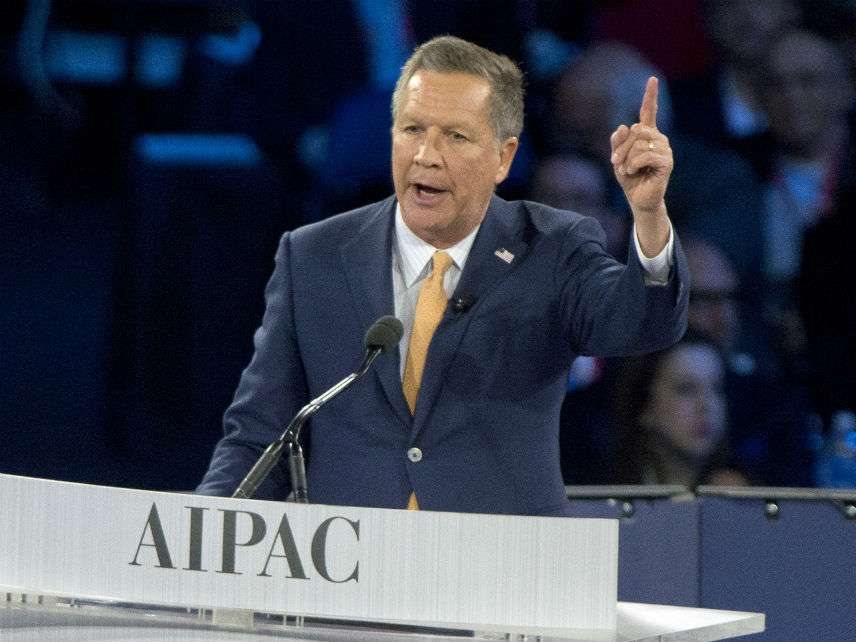The Fantasy of a 2020 Independent Centrist
John Kasich, Mark Cuban, and an army of op-ed political strategists are wrong if they think you can just whip up an independent presidential candidacy or new third party from scratch.
For a certain type of sports fan (coughs loudly to self) there is no sweeter part of the season than the day after the World Series or Super Bowl. Why? Because that's when you can construct fantasy rosters divorced from all real-world constraints.
This is roughly where we're at with the 2020 presidential election. The midterms are over; the official candidacies have yet to be announced. (Sorry, Julián Castro, "exploring" doesn't count.) Political commentators are busy unleashing their inner Strat-O-Matic manager and the position they seem most eager to fill is the one that stubbornly refuses to exist: the viable independent centrist.
So are you ready for that Joe Biden/Mitt Romney unity ticket? Conservative D.C. socialite Juleanna Glover, writing in Politico, sure is! Ideologically adrift Washington Post columnist Jennifer Rubin is dreaming of "a new party or a center-right independent ticket," headed by blue-state Republican Gov. Larry Hogan of Maryland. And there is no TV camera in front of which Ohio Gov. John Kasich won't float his own centrist boat.
"Let's just say that Donald Trump is nominated and Elizabeth Warren is nominated," Kasich said on ABC's "This Week" last month. "You have this ocean of people who sit in the middle."
"Shark Tank" star/investor Mark Cuban is shooting up his own independent flares. Cybersecurity and cryptocurrency pioneer John McAfee is trying to out-crazy Trump. The Kanye West administration may have been pushed back to 2024, but dare we fantasize in the meantime about President LeBron James?
The allure of Strat-O-Matic centrism goes beyond simple escapism from our dispiriting political slog. In a country where more survey respondents have self-identified as "independent" than either Democrat or Republican in each Gallup poll since December 2012, the market for a third political product would seem robust and unmet.
There's a "six-lane highway down the middle" of the two major parties, Libertarian presidential nominee Gary Johnson was fond of saying in 2016. Then again, that message won Johnson just 3.3 percent of the national vote when he ran against the two most loathed candidates in modern history.
Therein lie some sobering lessons. American politics resists fantasy league-style play. There are massive structural impediments to any nontraditional run at the White House–starting with a polarized electorate's sharp disdain for squishy centrists.
Last month's midterms were not promising for independents and other outsider candidates. Voter passion produced the highest nonpresidential turnout since women gained the franchise, but all that blue-wave energy wasn't there to vote Green. Maryland's independent candidate for U.S. Senate, Neil Simon, polled at 8 percent, yet finished with 3.7 percent of the vote. Independent Connecticut governor hopeful Oz Griebel similarly polled at 8.3 percent but finished at 3.9. Normally, third-party candidates expect to lose about one-third of their polling support on election day. This year many lost half.
What's going on here? Short answer: Fear. And that certainly will play a key role in 2020 too. It's safe to say that the solid majority of Americans who have disapproved of Trump throughout his presidency are horrified at the prospect of what he could do with another four years. That does not bode well for the next Jill Stein or Ralph Nader.
Beyond voter mood, there are bureaucratic roadblocks erected by the Democratic and Republican parties to protect their incumbent status. As people who toil in the salt mines of minor-party politics can tell you, fighting for ballot access is an expensive, full-time job. "In Illinois, the Libertarian Party has to turn in 25,000 valid signatures to get our candidates on the ballot for a general election," party Chair Nicholas Sarwark said in a conference call last week. "The Republicans and the Democrats only have to turn in a little less than 5,000."
Bill Kristol, co-founder of the just-shuttered Weekly Standard, found out the hard way in 2016 that it takes more to compete against Democrats and Republicans than just drawing a sketch on a cocktail napkin. In May of that year, after Trump had rolled through GOP primary season, Kristol unveiled a new conservative "independent candidate—an impressive one, with a strong team and a real chance." You'll be forgiven for not remembering the short and unhappy political career of David French.
After French wisely opted out, that conservative anti-Trump energy eventually transferred to former CIA officer Evan McMullin, who took an immediate crash course in petition-gathering, lawsuit-filing, and deadline-missing. In the end, McMullin got on the ballot in only 11 states; he finished third in only two.
In 2018, Kristol has at least learned his lesson enough to be searching for a Trump challenger within the GOP. Perennial presidential trial balloonist Michael Bloomberg, too, has rejected independent status if he runs.
It may not be the reality I prefer, but Donald Trump and Bernie Sanders taught us in 2016 that the most viable current path for an independent-bent candidate is to run an outsider campaign from inside an old-party tent.
And for the Mark Cubans of the world? Either start right now putting in the work of breaking down ballot barriers and/or wooing minor parties, or accept that this isn't the real political life, it's just a fantasy.
This article originally appeared in the Los Angeles Times.



Show Comments (59)